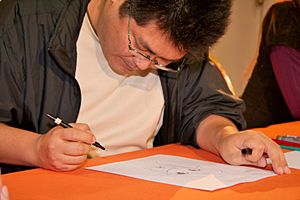Manga artist facts for kids
A manga artist (漫画家, manga-ka) is a special kind of comic artist. They create and draw manga, which are Japanese comics. In Japan, there are thousands of professional manga artists. Many of them go to art schools or learn from other artists. Sometimes, an artist becomes famous by winning a contest. For example, Naoko Takeuchi, who created Sailor Moon, won a big award. Also, Osamu Tezuka, a very famous manga pioneer, started without being an assistant.
Manga artists become well-known when their work gets noticed. This can happen through contests held by manga publishers. They might also create a "one-shot" manga, which is a single story. If people really like it, it might become a regular series. Artists are also known for how many manga series they are working on at one time.
Contents
What Does "Manga Artist" Mean?
The Japanese word for manga artist is manga-ka (漫画家). This word has two parts.
- The first part, manga (漫画), means "comics." It refers to the type of art the artist creates.
- The second part, ka (家), shows that the person is an expert. It means they are a professional creator.
So, a "manga artist" is an expert in creating manga. If someone only writes the story but doesn't draw it, they are called a gensakusha (原作者).
How to Become a Manga Artist
In the past, to become a manga artist, you usually sent your drawings to contests. If you won, your work would be published. Then, you would get an editor and officially start your career.
Today, many artists share their work online. They post their manga on websites. Sometimes, big publishing companies like Shueisha discover these online artists. For example, the popular manga One-Punch Man started as a webcomic. Later, Shueisha began publishing a new version of it.
Working with Other People
Creating manga professionally is usually a team effort. Manga artists work with many different people. These people help them create, publish, and share their work.
The Editor's Role
Most professional manga artists work closely with an editor. The editor is like the boss of the manga artist. They help guide the creation of the series.
- Editors give advice on how the manga looks and is put together.
- They check the story to make sure it flows well.
- Editors also make sure the artist meets deadlines.
- They ensure the manga meets the company's standards.
Naoki Urasawa, a famous manga artist, said working with an editor is like a music producer working with a singer. Editors can also help promote the manga. They might even help with designs for anime shows or other products based on the manga. A famous example is Akira Toriyama (creator of Dragon Ball) and his editor, Kazuhiko Torishima.
Working with a Writer
Some manga artists write and draw their own stories. Others work with a separate writer. Even when working with a writer, the manga artist often helps with the dialogue. This is because the words must fit into the speech bubbles in the drawings.
Some successful manga artists have worked with writers for most of their careers. These include Takeshi Obata (who drew Death Note) and Tetsuo Hara (who drew Fist of the North Star).
Help from Assistants
Most manga artists have assistants. These assistants help them finish their work on time. The jobs of assistants can vary a lot. They are usually other artists who help with the drawings. A manga artist typically has at least three assistants. Some artists work in groups called "circles" instead of having assistants, like the team CLAMP. A few artists work completely alone, but this is rare.
Assistants often help with:
- Inking: Adding ink lines to the drawings.
- Lettering: Adding the text and speech bubbles.
- Shading: Adding shadows and tones.
Unlike Western comics, manga rarely uses a colorist because most manga is black and white. Sometimes, assistants draw backgrounds or small cameo appearances. This lets the main manga artist focus on drawing the main characters.
Assistants can also be specialists. For example, some might draw vehicles or animals. Others might be historical consultants for stories set in the past. Assistants almost never help with the story itself. They are usually listed in the manga's credits. Sometimes, their own small drawings or interviews appear in the manga collections.
Many famous manga artists started as assistants. For example, Eiichiro Oda (creator of One Piece) was an assistant to Nobuhiro Watsuki. It is also possible to be an assistant for your whole career. Some assistants work for several different manga artists at once. Many also create their own comics as a hobby.
See also
 In Spanish: Mangaka para niños
In Spanish: Mangaka para niños
- Bakuman, a manga series about becoming a manga artist.
- The Comic Artist and His Assistants, a manga that shows what life is like for a manga artist.
- List of manga artists


